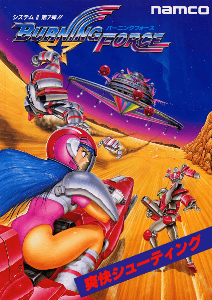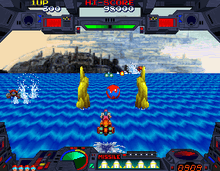Burning Force
Burning Force[lower-alpha 1] is a 1989 third-person shooter arcade game developed and published by Namco in Japan. A home conversion for the Sega Genesis was released worldwide a year later. The player assumes control of the 21-year-old space cadet Hiromi Tengenji, a pilot training to become a member of the Space Force, who must complete each level by shooting down enemies with her airbike and avoiding projectiles. Gameplay is similar to Space Harrier, featuring a fixed camera position behind the player and having similar mechanics. It runs on the Namco System 2 arcade hardware.
| Burning Force | |
|---|---|
 Promotional sales flyer | |
| Developer(s) | Namco |
| Publisher(s) | Namco |
| Composer(s) | Yoshinori Kawamoto |
| Platform(s) | Arcade, Sega Genesis, Wii Virtual Console |
| Release |
|
| Genre(s) | Third-person shooter |
| Mode(s) | Single-player, multiplayer |
| Cabinet | Upright |
| Arcade system | Namco System 2 |
Gameplay

In Burning Force, the player controls a 21-year-old space cadet named Hiromi Tengenji (天現寺ひろみ, Tengenji Hiromi), who as part of her final training, must battle high-tech enemies through six worlds of four areas on a futuristic airbike named "Sign Duck". The gameplay is similar to that of Sega's Space Harrier, but the worlds are divided into four areas and there is no vertical mobility making the game different in its own right; in the first two sections the player controls Hiromi on the airbike, which can move to the left and right, as well as braking and accelerating - and the airbike can also fire bullets and missiles at the enemies. The third area of every world is a boss area and the airbike will be transformed into a flying ship which can move in all directions; the fourth area of each world, however, is a bonus stage and the player has to collect as many spheres (which have numbers on them) as possible for bonus points.[1][2]
Reception
| Reception | ||||||||
|---|---|---|---|---|---|---|---|---|
| ||||||||
In Japan, Game Machine listed Burning Force on their December 1, 1989 issue as being the ninth most-successful table arcade game of the year.[4]
The Sega Genesis / Mega Drive received mixed and mostly mediocre reviews in the West upon the release, including 4/10 from ASM,[5] 5/10 from Génération 4,[6] 71% from Joystick,[7] 51% from Power Play,[8] and 77% from RAZE, which opined "Space Harrier is too old a formula to be successful nowadays."[9] The New Straits Times, in October 1990, dismissed the game as "yet another ... in the line of Space Harrier clones."[10] It also had mediocre sales.[11]
Retrospectively, Hardcore Gaming 101's Kurt Kalata opined it "is among the better of [Space Harrier] clones, partly because it's based on more powerful arcade hardware (the Namco System-II, which ran Phelios and Valkyrie no Densetsu, amongst others), and partly because it puts its own unique spin on the formula."[1] Next Generation listed the Genesis version at number 93 in their "Top 100 Games of All Time", explaining that "What earns Burning Force its place on this list is level design, the fact that no enemies are repeated from level to level, and the stunning design of the bosses."[11]
Legacy
Hiromi Tengenji went on to reappear in an advertisement on an airship in Mach Breakers (along with Pac-Man, Prince Gil and Princess Ki from The Tower of Druaga, Wonder Momo, Valkyrie from Valkyrie no Densetsu, and Pitto and Patti from Tinkle Pit) and also appeared in the Namco System 12-era World Stadium games as the Nikotama Gals' defensive half. She is one of player's party characters in Namco x Capcom, where she is partners with Toby "Kissy" Masuyo, the main character of the Baraduke games.[1] In ShiftyLook's Namco dating sim Namco High, she appears as one of 18 dateable characters. Namco Game Sound Express Vol. 02 - Burning Force, published by Victor Entertainment in 1990, contains the original soundtrack from Burning Force with compositions by Yoshinori Kawamoto.
Notes
References
- Kalata, Kurt (2013-05-21). "Burning Force". Hardcore Gaming 101. Retrieved 2015-11-07.
- "バンダイナムコ、「バーニングフォース」を7月14日にバーチャルコンソール アーケードで配信開始 -GAME Watch". Game.watch.impress.co.jp. Retrieved 2015-11-07.
- Douglas, Jim (December 1991). "Burning Force" (PDF) (40). Advanced Computer Entertainment. p. 104. Archived from the original (PDF) on 22 February 2020. Retrieved 22 February 2020.
- "Game Machine's Best Hit Games 25 - テーブル型TVゲーム機 (Table Videos)". Game Machine (in Japanese). No. 369. Amusement Press, Inc. 1 December 1989. p. 29.
- "DIE Kult-Seite über die alten Spiele-Magazine und Retro-Games!". Kultboy.com. Retrieved 2015-11-07.
- "Le site des anciennes revues informatiques". www.abandonware-magazines.org. Retrieved 2015-11-07.
- "Le site des anciennes revues informatiques". www.abandonware-magazines.org. Retrieved 2015-11-07.
- "Power.Play.N34.1991.01-kultpower". Archive.org. Retrieved 2015-11-07.
- "Raze Magazine Issue 03". Archive.org. Retrieved 2015-11-07.
- "New Releases". New Straits Times. October 25, 1990. Retrieved September 24, 2016.
- "Top 100 Games of All Time". Next Generation. No. 21. Imagine Media. September 1996. p. 38.